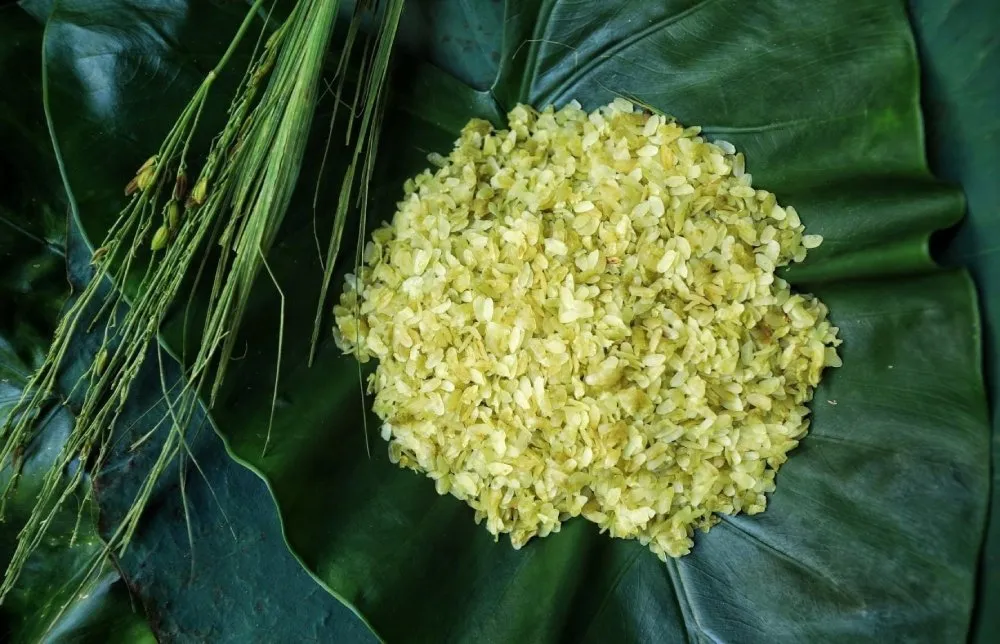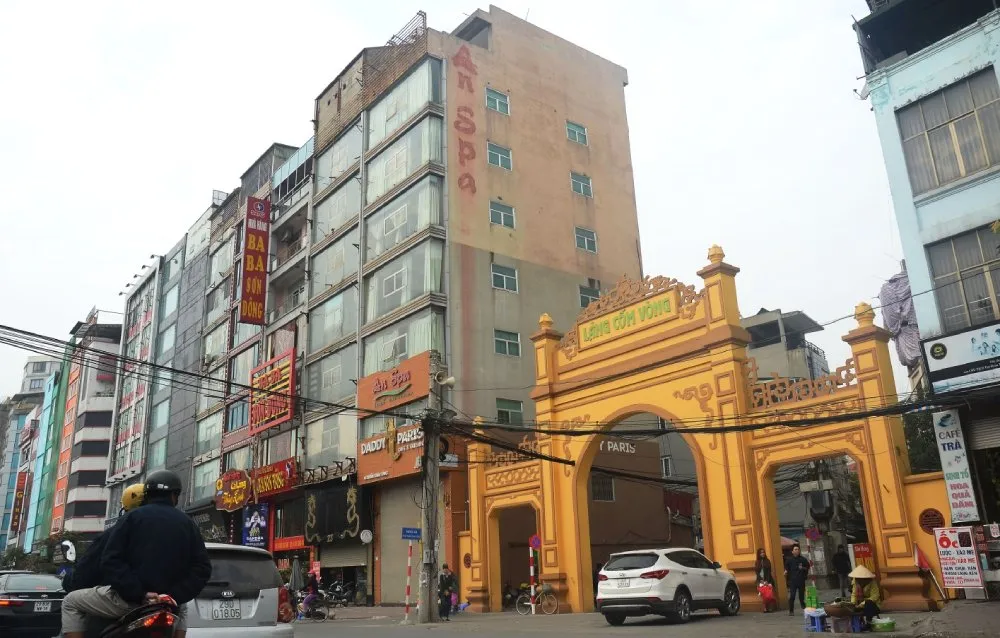As autumn arrives, Hanoi is filled with the verdant hue of young cốm (green rice flakes), a refined delicacy embodying the essence of the countryside. More than just food, Vòng village cốm is a cultural symbol, a crystallization of nature’s bounty and the skillful hands of artisans. Visiting Vòng village offers not only the chance to savor this special treat but also to experience the traditional cốm-making process – a unique and profound culinary journey.
Vòng Village: Preserving the Soul of Traditional Cốm Craft
Vòng Village, also known as Hậu Village, is located in Dịch Vọng Hậu Ward, Cầu Giấy District, Hanoi. Nestled amidst the bustling capital, Vòng village retains the simple, rustic charm of an ancient Vietnamese village. Renowned for its traditional cốm-making craft, it is also an attractive cultural destination, drawing visitors with its peaceful beauty and long-standing historical and cultural values.

From the village entrance, the sight of vibrant green cốm trays displayed along the path has become a distinctive sign of the craft village. Stepping deeper inside, you’ll sense a slower, more tranquil pace of life, contrasting sharply with the outside hustle and bustle. Narrow winding alleys, houses with moss-covered tile roofs, and especially the rhythmic sound of pestles pounding cốm all blend together to create a serene countryside picture, imbued with the spirit of Northern Vietnam.
The history of Vòng village’s cốm-making craft is linked to a legend from the time King Lý Thái Tổ moved the capital to Thăng Long (Hanoi’s former name). The story of a Vòng village young man who invented cốm during a year of crop failure has become a source of pride for the locals. Through ups and downs, the cốm craft has been preserved and developed by generations of Vòng villagers, becoming an indispensable part of Hanoi’s culinary culture.
Experiencing Cốm Making in Vòng Village: From Young Rice Grain to Exquisite Delicacy
Experiencing cốm making in Vòng village is not just a simple tourist activity, but also an opportunity for you to discover the elaborate and meticulous processing, and feel the dedication of the artisans poured into each grain of cốm. From selecting ingredients to completion, each step requires skill, experience, and a deep love for the craft.
Step 1: Selecting Nếp Cái Hoa Vàng – The “Soul” of Cốm
The main ingredient for Vòng village cốm is Nếp Cái Hoa Vàng, a special variety of sticky rice known for its distinctive aroma and natural stickiness. To achieve delicious cốm, choosing the rice is crucial. Nếp Cái Hoa Vàng must be young rice, freshly milky, with green and plump grains. Cốm makers must have experience to recognize when the rice reaches the ideal “milk-ripe” stage, ensuring the cốm is most pliable and fragrant.

Step 2: Roasting Cốm – The Secret to Creating a Distinctive Flavor
After the rice is threshed and carefully sieved, the roasting stage plays a decisive role in the quality and flavor of the cốm batch. Paddy rice is roasted in a cast iron pan over a wood-fired stove, with even and moderate heat. The roaster must continuously stir evenly to ensure the rice cooks uniformly without burning. Cốm roasting experience is passed down through generations, requiring a refined sense of temperature and time. Properly roasted paddy rice is achieved when the grains are “2 quằn 3 róc” – meaning when pressing 5 grains onto a wooden piece, 2 grains curl up and 3 grains shed their husks.
Step 3: Pounding Cốm – The Resonating Rhythm of the Craft Village
After roasting, the paddy rice is cooled and then put into a mortar for pounding. This is the most strenuous step, requiring strength and rhythmic coordination. The cốm pounder must pound evenly and continuously for about 10-15 minutes per batch. The pounding process is usually performed 7 times, each time followed by sieving to remove chaff and husks. The “clack-clump” sound of pestles pounding cốm echoes throughout Vòng village, becoming a characteristic sound, heralding the cốm season.

Step 4: Completion and Enjoyment – Autumn Culinary Essence
After undergoing many meticulous steps, young, fragrant, and pliable green cốm grains are born. Vòng village cốm is delicious not only because of its natural flavor but also because of the dedication and passion of the makers. Cốm is often wrapped in lotus or ráy leaves, both preserving its distinctive aroma and enhancing the delicate beauty of this treat.
The experience of making cốm in Vòng village doesn’t stop at observing the process; you also have the opportunity to directly participate in the steps, from sieving paddy rice and roasting cốm to pounding cốm. The feeling of creating fragrant cốm grains with your own hands will surely be an unforgettable memory in your journey to explore Hanoi’s culinary culture.
Immerse Yourself in the Cultural Space of the Craft Village and Savor Authentic Cốm
Visiting Vòng village offers not only the cốm-making experience but also the chance to explore the cultural space of a traditional craft village. Strolling along the village paths, you’ll encounter ancient houses, moss-covered tile roofs, and scenes of daily life of the craft villagers.

You can visit traditional cốm production facilities, listen to stories about the craft and the lives of the local people. Cốm artisans are always willing to share their experience, secrets, and passion for the traditional craft.
To savor authentic Vòng village cốm, you should choose freshly made cốm, still retaining its aroma and natural pliability. Cốm can be eaten directly or paired with ripe bananas, creating a harmonious and refined flavor. In addition, from fresh cốm, Vòng villagers also create many other delicious dishes such as bánh cốm (cốm cake), chả cốm (cốm sausage), xôi cốm (sweet sticky rice with cốm), each dish carrying its own unique flavor.
Vòng Village Welcomes You to Experience and Discover
Vòng village is not only a familiar destination for Hanoians every autumn but also an attractive destination for visitors from all over who want to explore culinary culture and experience traditional craft villages. Coming to Vòng village, you will:
- Experience the traditional cốm-making process: From selecting rice, roasting, pounding to completing the product.
- Meet and chat with cốm artisans: Listen to stories about the craft and life.
- Enjoy authentic Vòng village cốm: Feel the fragrant, delicious, and uniquely pliable taste.
- Explore the cultural space of the craft village: Stroll through narrow alleys, admire ancient architecture.
- Buy cốm specialties and cốm products: Take them home as gifts for family and friends.
To get to Vòng village, you can choose various means of transport such as buses, motorbikes, private cars, or ride-hailing services. Buses are an economical and convenient public transport option, with many routes passing through the Cầu Giấy area. If you want to be proactive about time and move flexibly, motorbikes or private cars are suitable choices. In addition, Xanh SM electric car service is also a great suggestion, providing a smooth and environmentally friendly travel experience.

Conclusion
Experiencing cốm making in Vòng village is a unique and meaningful culinary and cultural journey. Not only will you enjoy the renowned delicious cốm, but you will also immerse yourself in the traditional craft village space, feel the dedication and meticulousness of the artisans, and further appreciate the beautiful cultural values of the nation. Come to Vòng village to experience and feel, and you will surely have unforgettable memories of Hanoi in autumn.